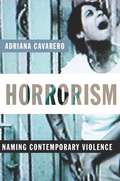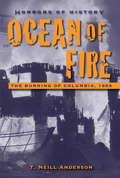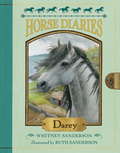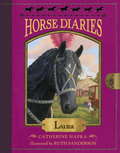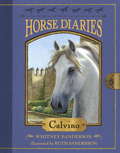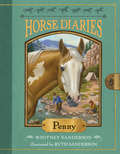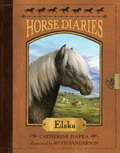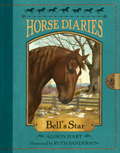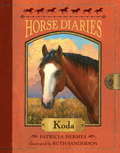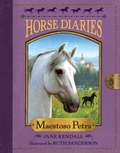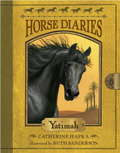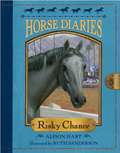- Table View
- List View
Horrorism: Naming Contemporary Violence (New Directions in Critical Theory #14)
by Adriana CavareroWords like "terrorism" and "war" no longer encompass the scope of contemporary violence. With this explosive book, Adriana Cavarero, one of the world's most provocative feminist theorists and political philosophers, effectively renders such terms obsolete. She introduces a new word-"horrorism"-to capture the experience of violence. Unlike terror, horrorism is a form of violation grounded in the offense of disfiguration and massacre. Numerous outbursts of violence fall within Cavarero's category of horrorism, especially when the phenomenology of violence is considered from the perspective of the victim rather than that of the warrior. Cavarero locates horrorism in the philosophical, political, literary, and artistic representations of defenseless and vulnerable victims. She considers both terror and horror on the battlefields of the Iliad, in the decapitation of Medusa, and in the murder of Medea's children. In the modern arena, she forges a link between horror, extermination, and massacre, especially the Nazi death camps, and revisits the work of Primo Levi, Hannah Arendt's thesis on totalitarianism, and Arendt's debate with Georges Bataille on the estheticization of violence and cruelty. In applying the horroristic paradigm to the current phenomena of suicide bombers, torturers, and hypertechnological warfare, Cavarero integrates Susan Sontag's views on photography and the eroticization of horror, as well as ideas on violence and the state advanced by Thomas Hobbes and Carl Schmitt. Through her searing analysis, Caverero proves that violence against the helpless claims a specific vocabulary, one that has been known for millennia, and not just to the Western tradition. Where common language fails to form a picture of atrocity, horrorism paints a brilliant portrait of its vivid reality.
Horrors of History: Ocean of Fire
by T. Neill AndersonBased on the actual fire that swept through Columbia, South Carolina, after the city surrendered to General Sherman's Union troops, Ocean of Fire details life in the South at the end of the American Civil War. Supported by thorough research, narrative accounts of actual historical persons as well as fictionalized characters comprise the novel. Follow 17-year-old Emma, her family, and potential Confederate spy, Charles Davis, as a chaotic community tries to survive a blazing firestorm. The second book in the Horrors of History series, Ocean of Fire makes history accessible, questioning who could have started this controversial fire and exploring how the closing weeks of the war affected citizens and slaves alike.
Horse Diaries #10: Darcy
by Ruth Sanderson Whitney SandersonIreland, 1917. Darcy is a light gray Connemara pony with silver dapples. She's fast and tough, whether she's pulling a load of peat from the bog or riding around the rugged countryside with Shannon McKenna, her human family's eldest daughter. But when Mrs. McKenna needs a doctor, Darcy discovers a skill that will change her and her family's life forever. Like Black Beauty, this moving novel is told in first person from the horse's point of view and includes an appendix full of photos and facts about Connemara ponies and Irish history.
Horse Diaries #12: Luna
by Catherine Hapka Ruth SandersonFor all lovers of horses and history, the beloved Horse Diaries series is heading to the circus! A beautiful Friesian horse and the younger sister of a circus star develop a heartwarming friendship in this sweet and lively story told straight from the horse's mouth. The Netherlands, 1855 Luna is a black Friesian mare with one small white crescent- moon marking on her forehead. She lives a quiet life on a farm . . . until the circus comes to town! Luna bonds with a girl named May, who dreams of starring in the show, just like her older sister. And together, Luna and May just might be able to shine. Here is Luna's story . . . in her own words.
Horse Diaries #14: Calvino
by Ruth Sanderson Whitney SandersonFor all lovers of horses and history! This latest book in the Horse Diaries series features an Andalusian horse in romantic sixteenth-century Spain. Southern Spain, 1570s Calvino is a dapple-gray Andalusian stallion. He grew up driving cattle in the mountains, but soon he catches the eye of King Philip II’s horse master. Now Calvino and his young rider, Rico, must learn the complicated moves of doma clásica riding. Calvino doesn’t understand the use of this prancing—until he and Rico are chosen to represent the king in a deadly bullfight that will put all his skills to the test. Here is Calvino’s story . . . in his own words. Praise for Elska (Horse Diaries #1): “A must for horse lovers, the cozy and exciting adventure will draw a wide audience.” —Booklist
Horse Diaries #16: Penny (Horse Diaries #16)
by Whitney SandersonFor all lovers of horses and history! In the latest book in the Horse Diaries series, meet Penny, a blue-eyed palomino paint mare who grows up in the Wild West of California during the Gold Rush!CALIFORNIA, 1850. Penny is a blue-eyed palomino paint mare with a taste for adventure! She and a boy named Jesse search for gold in the hills of Northern California. After striking it rich and then losing everything, Jesse and Penny join the Pony Express. The job is a tough one, but Penny loves a challenge! Here is Penny's story . . . in her own words.Love horses and history? Don't miss the stories of Elska, Bell's Star, Calvino, Lily, and more in the Horse Diaries series!
Horse Diaries #1: Elska (Horse Diaries #1)
by Catherine Hapka Ruth SandersonIceland, circa AD 1000Elska is a silver dapple Icelandic filly. She spends summers frisking about the countryside and winters in the farmyard, where the girl human Amma takes special care of her. But when a powerful neighbor notices Elska, her contented life suddenly changes. Here is Elska's story . . . in her own words.From the Hardcover edition.
Horse Diaries #2: Bell's Star
by Alison Hart Ruth SandersonVermont, 1850sBell's Star is a brown Morgan colt with a white star and two white stockings. He was bred for hard work, yet he longs to run free with his human friend, Katie, on his back. But when Star helps rescue a runaway slave girl, his ideas about freedom may change forever. Here is Star's story . . . in his own words. With exciting and knowledgeable text and lovely black-and-white art throughout--both by real horse owners--Horse Diaries are the perfect fit for all lovers of horses and history!From the Hardcover edition.
Horse Diaries #3: Koda
by Patricia Hermes Ruth SandersonFor anyone who has ever dreamed of hearing a horse's story . . .Independence, Missouri, 1846Koda is a bay quarter horse with a white blaze. He loves to explore the countryside and run free with his human friend Jasmine nearby. But after Koda sets out with Jasmine's family on a long and dusty wagon train journey on the Oregon Trail, he finds out what is truly important to him. Here is Koda's story . . . in his own words.With moving and knowledgeable text and lovely black-and-white art throughout--both by real horse people--this is the perfect fit for all lovers of horses and history!From the Trade Paperback edition.
Horse Diaries #4: Maestoso Petra (Horse Diaries #4)
by Ruth Sanderson Jane KendallVienna, Austria, 1938Maestoso Petra is a world-famous Lipizzaner stallion. He has spent years in the Spanish Riding School, training to perform the complex airs above the ground that only Lipizzaner can accomplish. But when World War II breaks out in Europe, he learns to think less about performing and more about survival. Here is Maestoso Petra's story . . . in his own words.From the Trade Paperback edition.
Horse Diaries #6: Yatimah
by Catherine Hapka Ruth SandersonFor all lovers of horses and history, it's the next book in the popular Horse Diaries series. Born in the Arabian Desert in the ninth century, Yatimah is a black Arabian filly whose name means "orphan." She enjoys her life at the oasis, with sheep to tease, other foals to race, and the daughter of her Bedouin owner to take care of her. But when the colt who is her foster brother is stolen in a raid, Yatimah realizes her true birthright. Like Black Beauty, this moving novel is told in first person from the horse's own point of view and includes an appendix full of photos and facts about Arabian horses and Bedouin culture.From the Trade Paperback edition.
Horse Diaries #6: Yatimah
by Catherine Hapka Ruth SandersonFor all lovers of horses and history, it's the next book in the popular Horse Diaries series. Born in the Arabian Desert in the ninth century, Yatimah is a black Arabian filly whose name means "orphan." She enjoys her life at the oasis, with sheep to tease, other foals to race, and the daughter of her Bedouin owner to take care of her. But when the colt who is her foster brother is stolen in a raid, Yatimah realizes her true birthright. Like Black Beauty, this moving novel is told in first person from the horse's own point of view and includes an appendix full of photos and facts about Arabian horses and Bedouin culture.From the Trade Paperback edition.
Horse Diaries #7: Risky Chance (Horse Diaries #7)
by Alison Hart Ruth SandersonFor all lovers of horses and history, it's the next book in the popular Horse Diaries series. Born in California at the start of the Great Depression, Risky Chance is a gray thoroughbred who was born to race. Life at the track and being spoiled by his jockey's young daughter, Marie, is all Chance could ask for. He loves nothing more than running fast and winning. But after an accident, Chance discovers a side of horse racing that has little to do with glory.Like Black Beauty, this moving novel is told in first person from the horse's own point of view and includes an appendix full of photos and facts about thoroughbreds, horse racing, and the Great Depression.From the Trade Paperback edition.
Horse Diaries #8: Black Cloud (Horse Diaries #8)
by Patricia Hermes Astrid SheckelsBorn in Northern Nevada in 1950, Black Cloud is a black-and-white mustang colt. He loves roaming free with the rest of his herd, playing with the other foals, and learning the ways of wild horses. But when humans intrude on this wandering life, Black Cloud's worled is changed forever. Like Black Beauty, this moving novel is told in first person from the horse's own point of view and includes an appendix full of photos and facts about mustangs and the history of the laws protecting them.From the Trade Paperback edition.
Horse Diaries #9: Tennessee Rose (Horse Diaries #9)
by Jane Kendall Astrid SheckelsAlabama, 1856. Tennessee Rose is a dark bay Tennessee Walking Horse with a rose-shaped marking on her forehead. She loves dashing around the plantation in the running walk that her breed is famous for, then coming back to her comfortable stall and her friend Levi, the slave boy who is her groom. But as the Civil War approaches, Rosie begins to question plantation life. Is slavery fair? Could Levi be free? Like Black Beauty, this moving novel is told in first person from the horse's point of view and includes an appendix full of photos and facts about Tennessee Walking Horses and the Civil War.
Horse Diaries: Koda
by Patricia HermesFor anyone who has ever dreamed of hearing a horse’s story . . . Independence, Missouri, 1846 Koda is a bay quarter horse with a white blaze. He loves to explore the countryside and run free with his human friend Jasmine nearby. But after Koda sets out with Jasmine’s family on a long and dusty wagon train journey on the Oregon Trail, he finds out what is truly important to him. Here is Koda’s story . . . in his own words. With moving and knowledgeable text and lovely black-and-white art throughout—both by real horse people—this is the perfect fit for all lovers of horses and history! From the Trade Paperback edition.
Horse People: Thoroughbred Culture in Lexington and Newmarket (Animals, History, Culture)
by Rebecca Louise CassidyThe world of Thoroughbred racing is glamorous, secretive, dangerous, and seductive—the sport of kings and the poor man's obsession. While the spectacle of racing stirs the imagination, it belies the ruthless business that lies beneath.This engaging original study demystifies this complex world by comparing centers of excellence in Britain and North America. Drawing from intensive field work in Suffolk's Newmarket and Kentucky's Lexington, Rebecca Cassidy gives us the inside track on all players in the industry—from the elite breeders and owners to the stable boys, racetrack workers, and veterinarians. She leads us through horse farms, breeding barns, and yearling sales; explains rigorous training regimens; and brings us trackside on race day.But the history of Thoroughbred racing culture is more than a collection of fascinating characters and exciting events. Cassidy's investigation reveals the factors—ethical, cultural, political, and economic—that have shaped the racing tradition.
Horse Racing in Britain and Ireland
by Anne HollandHistorian and experienced rider Anne Holland explores the history of horse racing, from the horses and jockeys, the history and racecourses, to betting and race-goers. The "Sport of Kings," racing dates back to contests between chariots at the ancient Olympics. Racing came to Britain with the Romans, and its popularity, particularly among the elite, led to the creation of the thoroughbred racehorse; and the establishment of a racing calendar with flat races and steeple chases at a plethora of dedicated racecourses around the country. Attending the races is a social activity no longer restricted to the elite, to the point that some racegoers enjoy a day out without every turning to watch the horses race by.
Horse Racing's Holy Grail: The Epic Quest For The Kentucky Derby
by Steve HaskinInterlaced with humor, this book looks at the pitfalls and pressures owners, trainers, and jockeys face at Derby time and why most fail, while others, notably the "big three" of D. Wayne Lukas, Bob Baffert, and Nick Zito, always seem to win the big prize.
Horse Sense: The Story of Will Sasse, His Horse Star, and the Outlaw Jesse James
by Janet Neubert SchultzWill Sasse is sick of his pa's slow, careful ways. Pa says only sturdy workhorses are worth raising out in farm country. Will wants to raise beautiful pleasure horses like his mare, Star. So what if it's a risk? Will wishes Pa was more like Jesse, a daring new friend. When Will is caught in a bloody shootout and a fatally botched bank robbery, he realizes that his friend is really the outlaw Jesse James. The James Gang is escaping—and they're taking Star with them. Will joins a posse in pursuit of the outlaws. As the posse closes in, Will realizes that he must make a choice—what kind of life does he really want?
Horse Soldiers
by Doug Stanton<P>From the New York Times bestselling author of In Harm's Way comes a true-life story of American soldiers overcoming great odds to achieve a stunning military victory. Horse Soldiers is the dramatic account of a small band of Special Forces soldiers who secretly entered Afghanistan following 9/11 and rode to war on horses against the Taliban. <P>Outnumbered forty to one, they pursued the enemy army across the mountainous Afghanistan terrain and, after a series of intense battles, captured the city of Mazar-i-Sharif, which was strategically essential to defeat their opponent throughout the country. <P>The bone-weary American soldiers were welcomed as liberators as they rode into the city, and the streets thronged with Afghans overjoyed that the Taliban regime had been overthrown. <P>Then the action took a wholly unexpected turn. During a surrender of six hundred Taliban troops, the Horse Soldiers were ambushed by the would-be POWs. Dangerously overpowered, they fought for their lives in the city's immense fortress, Qala-i-Janghi, or the House of War. At risk were the military gains of the entire campaign: if the soldiers perished or were captured, the entire effort to outmaneuver the Taliban was likely doomed. <P>Deeply researched and beautifully written, Stanton's account of the Americans' quest to liberate an oppressed people touches the mythic. The soldiers on horses combined ancient strategies of cavalry warfare with twenty-first-century aerial bombardment technology to perform a seemingly impossible feat. Moreover, their careful effort to win the hearts of local townspeople proved a valuable lesson for America's ongoing efforts in Afghanistan. <P><b>A New York Times Bestseller</b>
Horse Soldiers at Gettysburg: The Cavalryman's View of the Civil War's Pivotal Campaign
by Daniel MurphyCavalry operations during the Gettysburg campaign have been well covered, but never like this. Most cavalry treatments of the campaign and battle have focused on strategy, operations, and tactics and zoomed in on particular episodes: the Battle of Brandy Station in June 1863 (the largest cavalry engagement on American soil), Jeb Stuart&’s controversial ride-for-glory that deprived Lee of important intelligence for days, Union cavalry general John Buford&’s role in the start of the battle on July 1, and the cavalry battle involving not only Stuart but also George Armstrong Custer east of Gettysburg on July 3. Daniel Murphy&’s book covers the grand sweep of cavalry in the Gettysburg campaign, from Lee&’s crossing of the Rappahannock in early June 1863, through the epic three-day clash in Pennsylvania, to the conclusion of Lee&’s retreat in July 1863. But more than that, in a book blending strategy and tactics and campaign narrative with deep research in primary sources and an equestrian&’s sense for what it&’s like to ride and manage horses, Daniel Murphy brings a horseman&’s eye to the story of the campaign: how individual cavalrymen experienced the campaign from the saddle and how horses—with special needs for care and maintenance—were in fact weapons that helped shape battles.In this new narrative of Civil War cavalry, author Daniel Murphy gets into the saddle and explores what it was like to be a cavalryman during the Gettysburg campaign. Horse-soldiering was a unique way of doing battle, and Murphy gives it more justice and nuanced description than any author has yet given it.
Horse Soldiers: The Extraordinary Story of a Band of US Soldiers Who Rode to Victory in Afghanistan
by Doug StantonFrom the New York Times bestselling author of In Harm’s Way comes a true-life story of American soldiers overcoming great odds to achieve a stunning military victory. Horse Soldiers is the dramatic account of a small band of Special Forces soldiers who secretly entered Afghanistan following 9/11 and rode to war on horses against the Taliban. Outnumbered forty to one, they pursued the enemy army across the mountainous Afghanistan terrain and, after a series of intense battles, captured the city of Mazar-i-Sharif, which was strategically essential to defeat their opponent throughout the country. The bone-weary American soldiers were welcomed as liberators as they rode into the city, and the streets thronged with Afghans overjoyed that the Taliban regime had been overthrown. Then the action took a wholly unexpected turn. During a surrender of six hundred Taliban troops, the Horse Soldiers were ambushed by the would-be POWs. Dangerously overpowered, they fought for their lives in the city’s immense fortress, Qala-i-Janghi, or the House of War. At risk were the military gains of the entire campaign: if the soldiers perished or were captured, the entire effort to outmaneuver the Taliban was likely doomed. Deeply researched and beautifully written, Stanton’s account of the Americans’ quest to liberate an oppressed people touches the mythic. The soldiers on horses combined ancient strategies of cavalry warfare with twenty-first-century aerial bombardment technology to perform a seemingly impossible feat. Moreover, their careful effort to win the hearts of local townspeople proved a valuable lesson for America’s ongoing efforts in Afghanistan.
Horse Trading in the Age of Cars: Men in the Marketplace (Gender Relations in the American Experience)
by Steven M. GelberThe trading, selling, and buying of personal transport has changed little over the past one hundred years. Whether horse trading in the early twentieth century or car buying today, haggling over prices has been the common practice of buyers and sellers alike. Horse Trading in the Age of Cars offers a fascinating study of the process of buying an automobile in a historical and gendered context. Steven M. Gelber convincingly demonstrates that the combative and frequently dishonest culture of the showroom floor is a historical artifact whose origins lie in the history of horse trading. Bartering and bargaining were the norm in this predominantly male transaction, with both buyers and sellers staking their reputations and pride on their ability to negotiate the better deal. Gelber comments on this point-of-sale behavior and what it reveals about American men. Gelber's highly readable and lively prose makes clear how this unique economic ritual survived into the industrial twentieth century, in the process adding a colorful and interesting chapter to the history of the automobile.
Horse and Man in Early Modern England
by Peter EdwardsHorses were used for many purposes in Shakespeare's England: for travel, either on horseback or in carriages, for haulage and for pleasure, and for work in the fields. The upper classes were closely involved with horses, for jousting, hunting and racing. Horses was also essential to any army, both as cavalry and to draw supplies and artillery. Horse ownership was, however, much more widespread than might be imagined. <p><p> Horse and Man in Early Modern England shows how, in pre-industrial England, horses were bred and trained, what they ate, how much they were worth, how long they lived, and what their owners thought of them. <p><p> While they were named individually, and sometimes became favourites, many were worked hard and poorly treated, leading to their early deaths. They were, nevertheless an essential part of the life of the time and are strikingly depicted in literature and art, as well in many other records.
